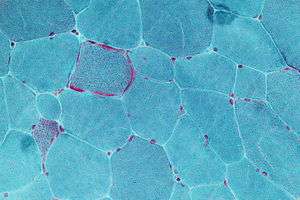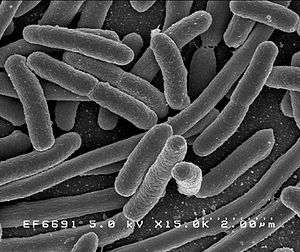Metabolic disorder
A metabolic disorder can happen when abnormal chemical reactions in the body alter the normal metabolic process.[3] It can also be defined as inherited single gene anomaly, most of which are autosomal recessive.[4]
| Metabolic disorder | |
|---|---|
 | |
| Example of mitochondrial disease | |
| Specialty | Endocrinology |
| Types | Calcium metabolism disorders, Acid-base imbalance, Metabolic brain diseases[1] |
| Diagnostic method | DNA test[2] |
| Treatment | Depends which type(See types) |
Symptoms
Some of the symptoms that can occur with metabolic disorders are lethargy, weight loss, jaundice and seizures. The symptoms expressed would vary with the type of metabolic disorder. There are four categories of symptoms: acute symptoms, late-onset acute symptoms, progressive general symptoms and permanent symptoms.[5]
Causes

Inherited metabolic disorders are one cause of metabolic disorders, and occur when a defective gene causes an enzyme deficiency.[6] These diseases, of which there are many subtypes, are known as inborn errors of metabolism.[7] Metabolic diseases can also occur when the liver or pancreas do not function properly.[3]
Types
The principal classes of metabolic disorders are:[1]
- Acid-base imbalance
- Metabolic brain diseases
- Disorders of calcium metabolism
- DNA repair-deficiency disorders
- Glucose metabolism disorders
- Hyperlactatemia
- Iron metabolism disorders
- Lipid metabolism disorders
- Malabsorption syndromes
- Metabolic syndrome X
- Inborn error of metabolism
- Mitochondrial diseases
- Phosphorus metabolism disorders
- Porphyrias
- Proteostasis deficiencies
- Metabolic skin diseases
- Wasting syndrome
- Water-electrolyte imbalance
Diagnosis

Metabolic disorders can be present at birth, and many can be identified by routine screening. If a metabolic disorder is not identified early, then it may be diagnosed later in life, when symptoms appear. Specific blood and DNA tests can be done to diagnose genetic metabolic disorders.[2]
The gut microbiota, which is a population of microorganisms that live in the human digestive system, also has an important part in metabolism and generally has a positive function for its host. In terms of pathophysiological/mechanism interactions, an abnormal gut microbioma can play a role in metabolic disorder related obesity.[8]
Screening
Metabolic disorder screening can be done in newborns via the following methods:[9]
- Blood test
- Skin test
- Hearing test
Management
Metabolic disorders can be treatable by nutrition management, especially if detected early. It is important for dieticians to have knowledge of the genotype to therefore create a treatment that will be more effective for the individual.[10]
References
- "MeSH Descriptor Data: Metabolic diseases". National Library of Medicine. Retrieved 27 July 2015.
- "Newborn Screening". MedlinePlus. Retrieved 27 July 2015.
- "Metabolic Disorders: MedlinePlus". www.nlm.nih.gov. Retrieved 27 July 2015.
- Graef, John W.; Wolfsdorf, Joseph I.; Greenes, David S. (2008). Manual of Pediatric Therapeutics. Lippincott Williams & Wilkins. ISBN 9780781771665.
- Fernandes, John; Saudubray, Jean-Marie; Berghe, Georges van den (2013-03-14). Inborn Metabolic Diseases: Diagnosis and Treatment. Springer Science & Business Media. p. 4. ISBN 9783662031476.
- "Inherited Metabolic Disorders Overview: Overview, Clinical Features and Differential Diagnosis, Epidemiology and Statistics". 2018-08-09. Cite journal requires
|journal=(help) - "Inborn errors of metabolism". MedlinePlus Medical Encyclopedia. Retrieved 27 July 2015.
- Hur, Kyu Yeon; Lee, Myung-Shik (2015-06-01). "Gut Microbiota and Metabolic Disorders". Diabetes & Metabolism Journal. 39 (3): 198–203. doi:10.4093/dmj.2015.39.3.198. ISSN 2233-6079. PMC 4483604. PMID 26124989.
- "Newborn Screening: MedlinePlus". www.nlm.nih.gov. Retrieved 2015-09-06.
- Acosta, Phylis (2010). Nutrition Management of Patients with Inherited Metabolic Disorders. Jones and Bartlett. p. 2. ISBN 9781449633127. Retrieved 27 July 2015.
Further reading
- Hoffmann, Georg F.; Zschocke, Johannes; Nyhan, William L. (21 November 2009). Inherited Metabolic Diseases: A Clinical Approach. Springer. ISBN 9783540747239.
- Gonzalez-Campoy JM, St Jeor ST, Castorino K, Ebrahim A, Hurley D, Jovanovic L, Mechanick JI, Petak SM, Yu YH, Harris KA, Kris-Etherton P, Kushner R, Molini-Blandford M, Nguyen QT, Plodkowski R, Sarwer DB, Thomas KT, American Association of Clinical Endocrinologists, American College of Endocrinology and the Obesity Society (September–October 2013). "Clinical practice guidelines for healthy eating for the prevention and treatment of metabolic and endocrine diseases in adults: cosponsored by the American Association of Clinical Endocrinologists/the American College of Endocrinology and the Obesity Society". Endocr Pract. 19 (Suppl 3): 1–82. doi:10.4158/EP13155.GL. PMID 24129260. Archived from the original on 4 March 2016. Retrieved 27 July 2015.